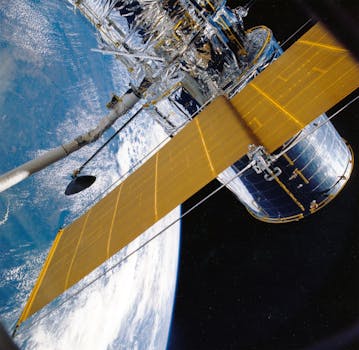
The Rise of Mega-Constellations: Latest Updates in Satellite Telecommunications
The rise of mega-constellations is revolutionizing Satellite Telecommunications, with thousands of small satellites being launched into low Earth orbit to provide global internet connectivity. This new era in space technology is transforming the way we communicate, with Satellite Telecommunications playing a vital role in bridging the digital divide and providing internet access to remote and underserved communities.
One of the key drivers of this trend is the increasing demand for global internet connectivity. With the proliferation of mobile devices and the growing need for online services, there is a pressing need for reliable and high-speed internet access. Satellite Telecommunications is well-positioned to meet this demand, with its ability to provide coverage to remote and hard-to-reach areas.
What are Mega-Constellations?

Mega-constellations refer to a large group of small satellites that are launched into low Earth orbit to provide global internet connectivity. These satellites are typically smaller and less expensive than traditional satellites, making them more cost-effective and efficient. The idea behind mega-constellations is to create a network of satellites that can provide continuous coverage of the Earth, allowing for seamless communication and internet access.
Some of the key players in the mega-constellation market include SpaceX, Amazon, and OneWeb. These companies are investing heavily in the development and launch of small satellites, with the goal of providing global internet connectivity. For example, SpaceX’s Starlink constellation aims to provide high-speed internet access to remote and underserved communities, while Amazon’s Kuiper Systems is developing a constellation of 3,236 satellites to provide global internet connectivity.
Benefits of Mega-Constellations

The benefits of mega-constellations are numerous. One of the most significant advantages is the ability to provide global internet connectivity, bridging the digital divide and providing access to remote and underserved communities. Mega-constellations can also provide backup connectivity in the event of a disaster or outage, ensuring that critical communications systems remain online.
In addition to providing internet connectivity, mega-constellations can also be used for a variety of other applications, including navigation, remote sensing, and weather forecasting. The data collected by these satellites can be used to improve our understanding of the Earth and its systems, leading to better decision-making and more effective management of resources.
Challenges and Concerns

While mega-constellations offer many benefits, there are also challenges and concerns that need to be addressed. One of the most significant concerns is the risk of space debris, with the launch of thousands of small satellites into low Earth orbit. This can increase the risk of collisions and damage to other satellites, as well as the International Space Station.
Another concern is the impact of mega-constellations on the environment. The launch of large numbers of satellites can contribute to climate change, with the production and launch of these satellites resulting in significant greenhouse gas emissions. There are also concerns about the impact of mega-constellations on astronomy, with the brightest satellites interfering with the ability to observe the night sky.
Finally, there are regulatory challenges that need to be addressed, with the need for clear guidelines and standards for the launch and operation of mega-constellations. This includes ensuring that these satellites comply with international regulations and do not interfere with other satellite systems.
See more:





